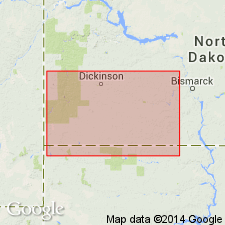
- Usage in publication:
-
- Slope Formation
- Modifications:
-
- Named
- Dominant lithology:
-
- Clay
- Silt
- Sand
- Lignite
- AAPG geologic province:
-
- Williston basin
Summary:
Named as a formation (1 of 5) in Fort Union Group; named for Slope Co, ND, Williston basin. Type area T105N, R135W, in Slope Co; type section in south-facing exposure northwest corner sec 15 and southwest corner sec 10, T105N, R135W. Occurs southwestern ND along western margin Williston basin into eastern MT, apparently as far south as Cedar Creek anticline. Lower part of Slope Formation present in northwestern SD. Consists of alternating beds of clay, silt, sand, lignite. Clay and silt unbedded or thinly laminated but nonfissile. Sand has plane bedding or large-scale or small-scale cross-bedding. Lignite comprises less than a tenth total thickness and typically seen in beds less than 4 m thick. As a whole, formation predominantly drab, brownish gray. About 90 m thick in its type area; northward thins to 20 m in Morton Co, ND. Includes several informal units--"Lower Coal Pair, Upper Coal Pair, Glasswort Clay, Yule Bed" at type section. Overlies Cannonball Formation of Fort Union Group in central ND; overlies "T-Cross Bed," an informal unit at top of Ludlow Formation at slope type section and Ludlow Formation of Fort Union Group in western ND. Unconformably underlies Bullion Creek Formation (new) of Fort Union Group. Top marked by white bleached zone. Cross section. Columnar sections. Slope consists of strata previously considered upper part of Ludlow Formation or part of Tongue River Formation. Of Paleocene age.
Source: GNU records (USGS DDS-6; Denver GNULEX).
For more information, please contact Nancy Stamm, Geologic Names Committee Secretary.
Asterisk (*) indicates published by U.S. Geological Survey authors.
"No current usage" (†) implies that a name has been abandoned or has fallen into disuse. Former usage and, if known, replacement name given in parentheses ( ).
Slash (/) indicates name conflicts with nomenclatural guidelines (CSN, 1933; ACSN, 1961, 1970; NACSN, 1983, 2005, 2021). May be explained within brackets ([ ]).

